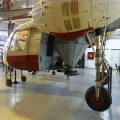
Bristol Belvedere | |
|---|---|
| País | Reino unido |
| Papel | Helicóptero de carga |
| Primeiro voo | 5 de julho de 1958 |
| Construído | 26+ |
O Bristol Tipo 192 Belvedere É um helicóptero militar bimotor britânico construído pela Bristol Aeroplane Company. Foi projetado por Raoul Hafner para uma variedade de funções de transporte, incluindo transporte de tropas, queda de suprimentos e evacuação de baixas. Foi operado pela Força Aérea Real (RAF) de 1961 a 1969. O Belvedere foi o único helicóptero rotor tandem da Grã-Bretanha a entrar em produção, e um dos poucos não construídos por Piasecki ou Boeing.
| Westland Type 192 Belvedere HC 1 Walk Around | |
|---|---|
| Fotógrafo | Desconhecido |
| Localização | Desconhecido |
| Fotos | 34 |
Veja também:
O Bristol Belvedere foi um helicóptero notável que serviu em várias funções para os militares britânicos. Foi projetado por Raoul Hafner, um pioneiro da engenharia de helicópteros, que já havia criado o Bristol Sycamore. O Belvedere tinha dois motores e dois rotores montados em conjunto, o que lhe dava mais potência e estabilidade do que os helicópteros convencionais de rotor único. Podia transportar até 18 soldados ou 12 macas, bem como carga e armas sob sua fuselagem.
O Belvedere originou-se de um projeto civil, o Bristol Type 173, que voou pela primeira vez em 1952. No entanto, o Type 173 foi cancelado e Bristol se concentrou no desenvolvimento de versões navais do helicóptero para guerra anti-submarina. Estes também foram cancelados, mas a Royal Air Force mostrou interesse em usar o helicóptero para missões de transporte e apoio. Assim, nasceu o Bristol Type 192 Belvedere.
O primeiro protótipo do Belvedere voou em 5 de julho de 1958 e entrou em serviço com a RAF em 1961. Foi implantado em vários locais ao redor do mundo, incluindo Aden, Bornéu, Chipre, Alemanha, Hong Kong, Malásia e Cingapura. Ele executou tarefas como transporte de tropas, entrega de suprimentos, evacuação de vítimas, resgate ar-mar e combate a incêndios. Também foi usado para treinamento de pára-quedas e operações especiais.
O Belvedere tinha algumas desvantagens que limitavam seu desempenho e popularidade. O trem de pouso dianteiro era muito alto para permitir fácil acesso à porta da cabine. Os motores eram barulhentos e ocupavam espaço dentro da cabine. Os rotores geraram um forte downwash que dificultou o carregamento e o descarregamento. O helicóptero também sofria de problemas de confiabilidade e altos custos de manutenção.
O Belvedere foi retirado de serviço em 1969, após apenas oito anos de operação. Foi substituído por helicópteros mais modernos, como o Westland Wessex e o Puma. Apenas um Belvedere sobrevive hoje no The Helicopter Museum (UK) (en) em Weston-super-Mare.
Visualizações : 863












